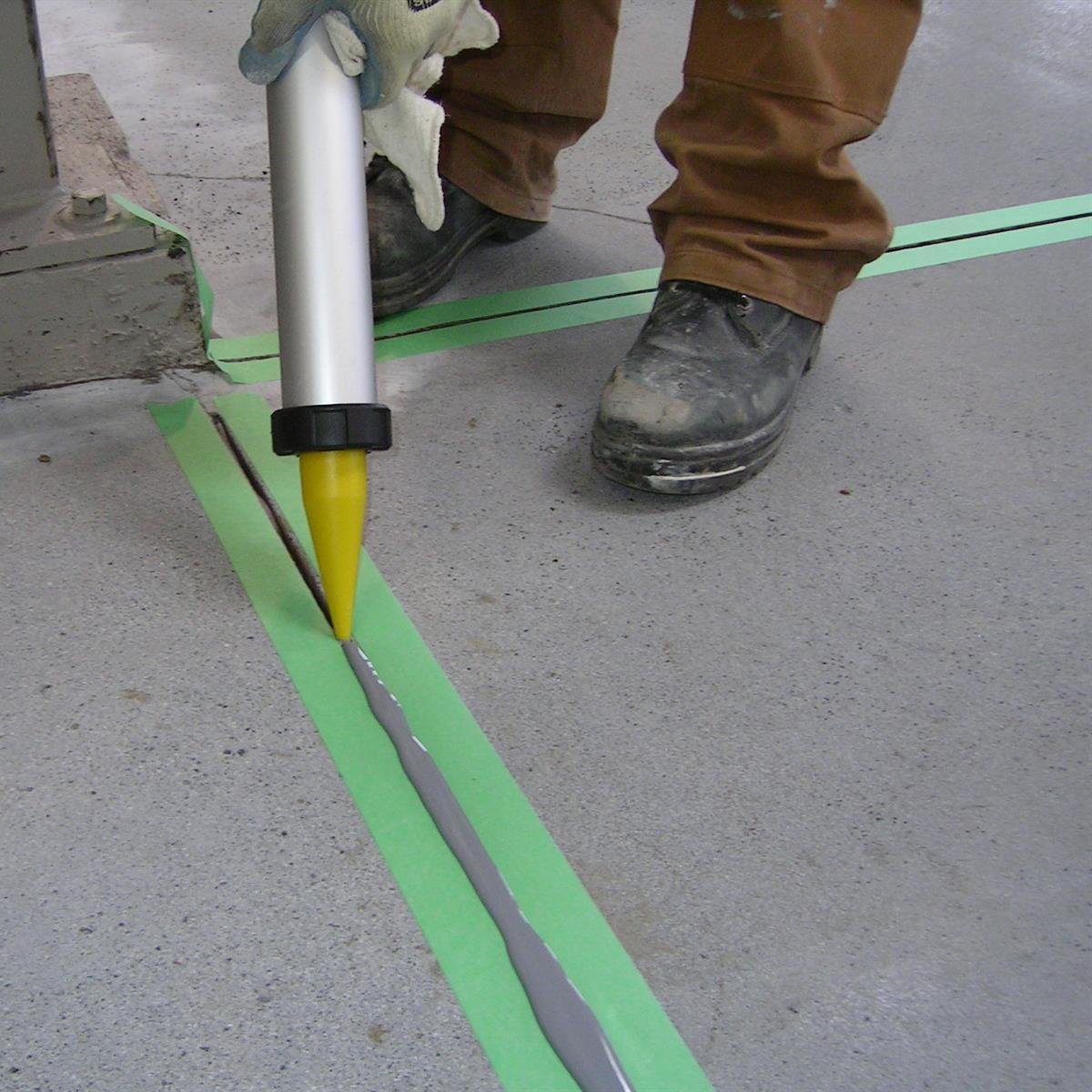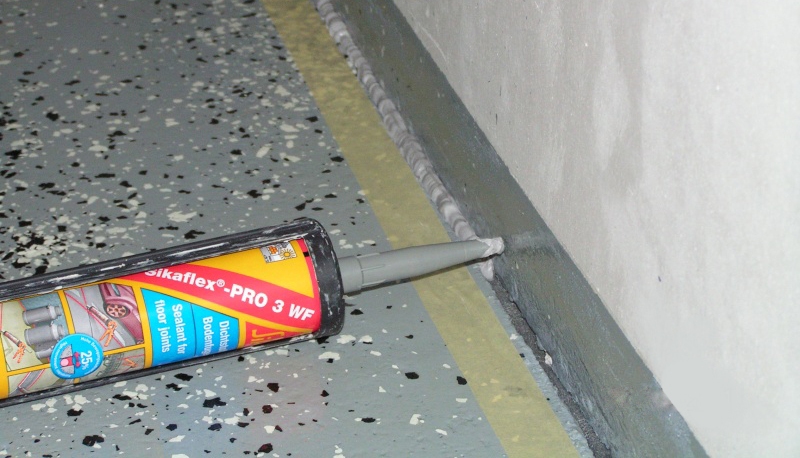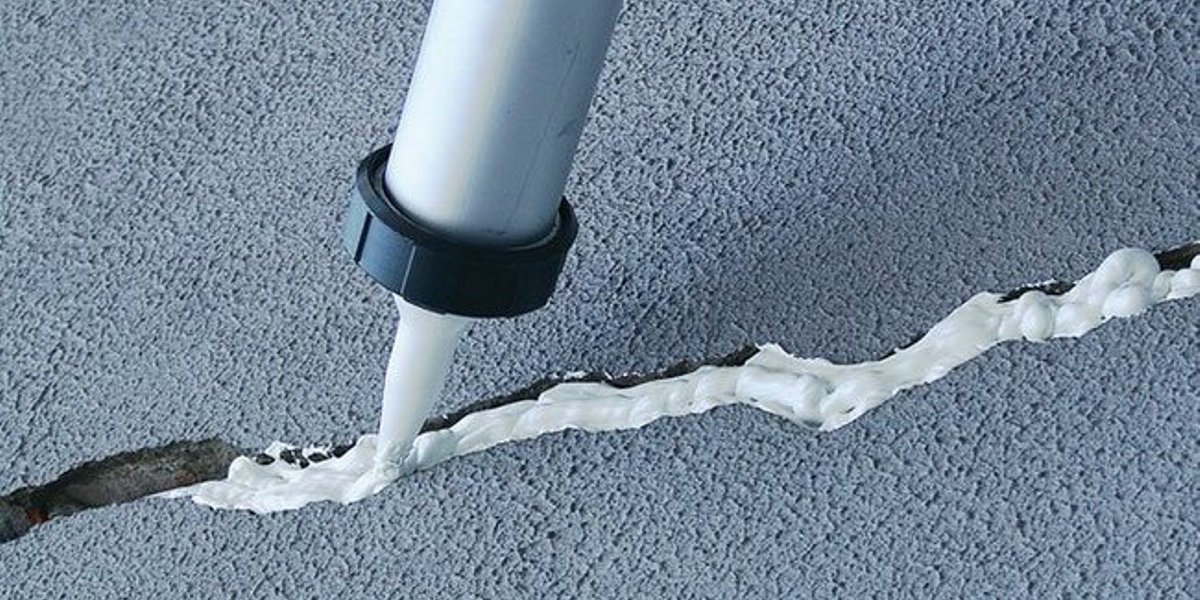Self-contained construction of a waterproof expansion joint with a metal profile
The device of expansion joints in concrete floors can be carried out using a special metal profile, which is important in industrial premises.
How to make a waterproof seam with a metal profile:
- With a long plastering rule or lace, a line for cutting grooves 20-30 wide and up to 4 centimeters deep (corresponds to the height of the metal profile) is marked.
- Cutting the seam with a wall chaser (several at once, followed by cutting the concrete with a perforator, cleaning with a circular grinder).

- Level control using a laser level.
- Filling the bottom of the seam with a layer of hardened polymer concrete, finishing the surface.
- Inserting special bolts into the profiles, setting them in the correct position, joining the two profiles into a one-piece structure with fixing with nuts and connecting elements. The distance between the profiles can be different, it is indicated in the project, taking into account the type of expansion joint. Make sure that the bottom plane of the profiles lies without distortions to either side. The profile fits into place without effort. At the joints of the profiles, there is a guide rod and a hole, which guarantee the strength of the connection of several elements into one structure. Before joining, the elements can be smeared with high-quality metal glue.

Fixing the profile with dowels, drilling on horizontal wide planes of the hole of the required diameter according to the size of the plastic elements of the dowels. The approximate depth of the hole that is being drilled should be 2-3 centimeters more than the length of the dowel, then it will be easier to drive it in.
Screwing the metal elements of the dowels up to the stop with an electric drill, checking the quality of fixation. The dowels are attached in 40-50 centimeters increments.
Dismantling the installation kit - removing the nuts and the metal tie, which is fastened with bushings with an internal thread. After unscrewing the bolts, it is possible not to cut off, since they are located below the upper plane of the profiles and in the future a decorative insert will be fixed to them
On the profiles, you also need to unscrew the nuts for the temporary fixing of the bolts.
Laying the elastic removable insert: a roll is rolled along the profile (starting from the end), pressed into the landing lugs carefully and until it stops. The insert should lie flat, without gaps and distortions, the remaining piece is cut off with a mounting knife.
Installation of decorative strips made of stainless alloy steel (most often used for stressed floors) or aluminum
The ends of the mounting bolts are included in the surface of the linings. Everything is fixed with nuts, the position is adjustable, excluding gaps between adjacent elements. Next, you need to remove the protective film.
Installation of a protective cover on the profile (it is removed after the coating has hardened).
.

Types of expansion joints
In practice, two types of cuts are used:
- insulating - they are equipped along the walls of the room in order to prevent the effect of deformation of the building envelope on the concrete floor. They are created using insulating material that is laid around the perimeter of the room;
- shrinkage - they are intended to prevent the appearance of cracks during the hardening of screeds from concrete mortar.

Wherein:
- elongated or L-shaped areas should be avoided;
- the length cannot exceed the width of the blocks by more than 1.5 times;
- the cuts must be made straight without branches.
Variety of sealants
There are a myriad of concrete sealants and their classifications.
Sealants can be categorized according to their mode of action.
- Superficial. As a result of their use, a strong impervious film is formed on the base, which does not allow the penetration of external aggressors. Depending on the sealant used, the film can be either matte or glossy.
- Penetrating. They completely cover the opening and protect against various environmental conditions.

They also differ in the components that are part of:
- silicone;
- acrylic;
- polyurethane;
- silicate;
- butyl rubber;
- bitumen;
- polysulfides.


Sealants can also be classified according to the criterion of their readiness for use.
- One-piece or one-piece. Such funds are already ready for use: they do not require additional intervention before carrying out work.
- Two-piece or two-piece. These sealants need preparation before use. Before using them, it is worthwhile to study well the technology written by the manufacturer on the packaging or cylinder.


There are several more criteria by which the types of sealants are formed.
By way of hardening:
- non-hardening (by their properties they resemble rubber);
- drying out (harden over time);
- vulcanizing;
- polymerizing.


By application method:
- spatulas (applied using a spatula);
- brush (a brush is required to apply the sealant);
- filling (special devices are used, for example, a gun).


One-component
Typically, such sealants are meant to be made of silicone. This is the most common type and is used almost universally. They have a number of advantages and positive qualities.
Pros:
- high resistance to various weather conditions;
- resistance to extremely low and very high temperatures;
- durability;
- complete impermeability;
- good adhesion to most surfaces;
- resistance to ultraviolet radiation, which has a destructive effect;
- elasticity.


Minuses:
- you cannot apply another layer of sealant (if it is necessary to seal, you will have to clean the surface of the old sealant);
- silicone sealants should not be painted, as the paint begins to flake off, however, colorants can be added as an additional substance before applying the sealant;
- can not be used in a room with a high level of humidity.


Two-component
They are irreplaceable when working with many surfaces, in particular concrete, sealants. They can be used to repair cracks of various sizes and severity. They are made by adding reagents to the ready-made solution in compliance with certain proportions, so inaccurate actions can spoil the result.
After their application, a quick polymerization process occurs, however, after a few days, shrinkage can be observed. An inelastic, strong film appears that does not allow acids and alkalis, chemicals, oils, fats and gasoline to pass through. Due to these properties of polysulfide compositions, they are used at gas stations, service stations, warehouses and facilities whose activities are closely related to electricity. Also, these sealants are used in energy-efficient glazing. The temperature range at which you can work with this product is quite high: from -50 to + 130 ° C.


Pros:
- durability if used correctly;
- good adhesion to a variety of materials: from wood to ceramics;
- assistance in creating durable structures;
- high speed of solidification.

Minuses:
- the need to accurately observe the proportions during manufacture;
- work with chemicals;
- if you make a mistake in the process, it will be undesirable to use the resulting sealant;
- you need to work quickly with the resulting composition, since it hardens quickly.


Protection methods
Before proceeding with waterproofing work, you must choose the appropriate method
It is important to take into account some criteria:
it is important to determine the depth and width of the seam;
take into account possible loads on it;
take into account the peculiarities of the construction of the building and its subsequent operation.


Suture waterproofing can be carried out during the construction of the structure, during operation, as well as during repair work. In the process of erecting a structure, certain types of joint sealing work are carried out:
- a special membrane is formed at the seam;
- the waterstops are carefully fixed;
- the seam is filled with sealant;
- a special elastic tape is fixed on the structure to improve the quality of sealing.
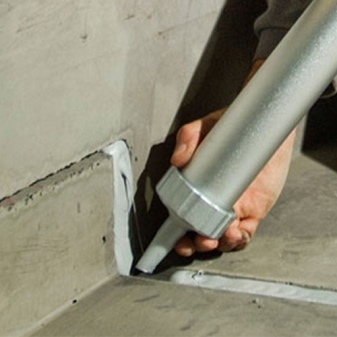

During the operation of the building, as well as during the repair, it is planned to carry out certain works to improve the quality of seam insulation and prevent depressurization.
Seams are filled with special sealants or similar materials with increased elasticity. Joint filling is also carried out using acrylic or polyurethane resins. For this, an injection method of waterproofing is used. Then elastic bands and waterstops are carefully fixed at the joints.


Flexible membrane for waterproofing joints
This material is used when the seam width is large enough. The membrane is secured with metal clamping strips to concrete edges. Before doing this, the cavity must be sealed with a highly adherent sealant. Cold joints are waterproofed using this material.
The negative side of this method is that it is impossible to apply it with a close location of bottom waters. For greater strength, a casing can be used, and a penetrating waterproofing that is covered over the concrete, making it waterproof. It is worth noting that if microscopic cracks go through the material, the integrity of the waterproofing will be violated, and additional insulation work will have to be carried out. Waterproofing of expansion joints is made using embedded rubber or polyurethane profiles. First, you need to install a waterproofing key, which is laid at the time of pouring the monolith. To do this, special plug-in elements are mounted in the formwork, with the help of them an expansion joint is subsequently formed, inside which there is a key.
Different types of dowels are used, it all depends on the effect on the expansion joints that the environment will have. In order to make the waterproofing even better, special grades of concrete with high water resistance are used. There is a special membrane waterproofing of joints, which is used as an alternative solution to the above-described method of sealing expansion joints between plates.
How to seal seams: a step-by-step diagram
Expansion joints also serve as "bridges" of cold, they must be sealed in order to reduce the thermal conductivity of the concrete screed. Sealing must be done strictly according to the rules, while not forgetting about careful surface preparation.
Tools and equipment
For work, you should purchase a suitable sealant, a deep penetration primer, as well as tools:
- narrow spatula for leveling the composition;
- priming brush;
- sealant gun.
 Construction guns for applying sealant and nozzles to them
Construction guns for applying sealant and nozzles to them
The gun is selected depending on the packaging of the purchased product: there are universal models, devices for sealants in tubes, cartridges, "sausages" or for bulk products. Professionals often use special equipment for high-precision and continuous supply of sealants, which is very important for a large processing area.
Surface preparation
Having carried out the correct preparation, you can be sure of the high quality of adhesion of the sealant to the concrete. The coating must be durable. If its areas are crumbling, it is worth cleaning them and treating them with a concrete mixture locally, and only after drying, make a seal.
During the preparatory measures, all debris is removed (with a broom, a brush or a vacuum cleaner, the cracks are blown with compressed air), and the surface is removed from traces of corrosion, decay, and mold. Be sure to degrease and remove old paint, on which the sealant does not fit well. Stubborn dirt is removed by grinding, sandblasting.
 Cleaning of seams in a concrete screed
Cleaning of seams in a concrete screed
Highly porous concrete is treated with a solvent to remove residues of dust, microfilms, preservatives. The presence of defects, pits, chips, depressions is unacceptable - they must be carefully repaired.
Cracks that are too narrow, on the other hand, are neatly widened. At the end of the preparation, the surface is treated with a primer with a high concentration of active ingredients. The treatment area should exceed the boundaries of the sealant application by at least 3-4 cm on each side.
Preparation of the composition
One-component products directly in the package just need to be inserted into the gun, as they do not require preparation. In two-component formulations, combine the paste and the hardener in the proportions indicated by the manufacturer. You cannot violate the ratio, otherwise the sealant will turn out to be tough or will not be able to harden. Stir the material for 3-5 minutes until a homogeneous mass is obtained. If too thick, the composition can be diluted with gasoline or white spirit (80 ml per 1 kg).
 Preparing a two-component compound for use
Preparing a two-component compound for use
Technology for applying curing sealants
It is better to apply the product from a pistol, but if it is not available, you can use a regular spatula. Fill cracks in the floor, evenly distributing the compound along the entire length of the joint. After that, a narrow spatula is moistened in soapy water, the sealant is leveled with the floor. The excess is immediately removed.
During work, it must be taken into account that the sealant begins to harden within a certain time. For example, acrylic compounds begin to cure after 15 minutes, on polyurethane a strong film appears after 1 hour. If the plastic characteristics of the mass have decreased, it will be difficult to apply it, the quality of the seam may decrease. Complete drying of the sealants usually lasts at least a day, after which the floor will be ready for use.
Technology for applying non-curing compounds
Such sealants are applied in a similar way using metal syringes, wooden or iron spatulas, hoses. Some products must be heated to + 30 ... + 50 degrees before use, as indicated in the instructions. The operating temperature of the seams should not be higher than +70 degrees, and the joints themselves should be closed from above with cement-sand mortars in order to increase the tightness.
 Filling joints in a concrete floor with a construction syringe
Filling joints in a concrete floor with a construction syringe
Post-processing
As it dries, the seam can be plastered, sprinkled with cement or sand in a layer of 1–2 mm. Some sealants can be overpainted if required.
Sealing
The next step after cutting concrete ditches is sealing them. A high-quality seal is necessary in order to protect the screed from moisture penetration deep into the concrete, as well as to prevent other damage.
There are several options for how this work can be carried out:
- use of a special sealant - due to its elasticity, it is very easy to work with mastics. In addition, they give a good effect and reliably protect concrete from water penetration;
- seals - the use of various sealing materials is also quite popular. They are especially well suited for the construction of insulating slots;
- special slats are another sealing option.These strips consist of a metal profile and a rubber strip and can be installed both in fresh concrete and in grooves made after it has dried.
 Compensation bar
Compensation bar
Whichever method is chosen, it will protect concrete floors only if you follow the technology of work
Therefore, it is always important to take your time and follow the manufacturer's instructions.
Necessary materials
A seam is a cut in a building structure. During the sealing process, it is filled with a special material.
The creation of seam waterproofing is a painstaking and responsible process, therefore, only proven and high-quality building materials are used for it. Most often they are used for this:
- Ground mixes. They include quartz sand, cement and various special chemical components.
- Waterproofing materials. During construction work, very often minor flaws are ignored, which can lead to negative consequences: the appearance of mold, dampness on the ceiling and walls inside the building. To eliminate them, waterproofing building materials are used.


- Very often, special seals are used to eliminate and prevent leaks.
- An excellent option for seam sealing are waterproofing cords. On contact with moisture, they tend to swell, thereby filling the space and eliminating any leaks. However, it should be noted that this material is only suitable for small seams.
- Waterproofing dowels are often used to optimally protect a building from moisture. They also perfectly compensate for the movement of the structure.
- Special sealants.




For the production of this type of waterproofing, special rubber and the latest technologies are used. High-strength and waterproof waterstops are available in a variety of shapes and sizes, allowing you to choose the right fit for any seam.

Views
There are several types of sealants for expansion joints in concrete on sale, which differ in chemical composition: silicone, silicate, thiokol, etc. In addition to chemical properties, acriplast must be water-resistant, frost-resistant.
Acrylic
Acrylic sealant is less resistant to sudden changes in temperature and humidity, so it is better to use it for internal treatment of concrete areas that do not require serious protection. Acriplast has good vapor permeability.
After application, a smooth film forms. This type is used to align the joining parts between walls, ceiling, floor.
The acrylic sealant does not contain solvents, therefore the dried surface can be subjected to subsequent processing (painting, varnishing).
Polyurethane
Polyurethane concrete joint sealant is a water resistant compound that is suitable for sealing joints while ensuring the durability and service life of the screed. For ease of application, a construction syringe is used, which will direct the flow of acriplast, thus avoiding runoff along the vertical plane. Since the polyurethane agent is able to withstand temperature changes, the influence of humidity, it can be used for external seams. The connection is obtained strong after complete drying of the permissible load.
Polyurethane components allow the compound to withstand exposure to chemicals, oils, alkalis and other complex elements. In terms of composition, they are divided into one-component, two-component.
Two-component polyurethane sealants prepared in compliance with the dosage prescribed in the instructions. Deviation from it will lead to loss of connection properties.
Silicone
Silicone sealant is demanding in the preparation of the work area.The compound to be processed must be thoroughly cleaned from dirt, dust and primed. Fulfillment of these requirements will ensure high adhesion.
The material is produced as one-component, multi-component, with a rubber base.
The advantages of raw materials include:
- thixotropy;
- there are no solvents in the composition;
- pasty consistency;
- after drying, a film forms;
- the mass, under the influence of air humidity, penetrates into the seam;
- the resulting seam is elastic, not subject to chemical, water attack, durable.
Thiokol
Thiokol mixture is an elastic sealant produced on polysulfides. They give the mass the properties of flexibility, resistance to the effects of oils, alkalis, saline solutions, etc. These are two-component compositions.
The prepared mixture is similar to flexible rubber, it does not shrink when dry. Protection of the seam from deformation during temperature extremes and aggressive environmental influences is formed.
Silane modified
Sealants of this kind have increased flexibility, which depends on the content of silane-modified polymers in the base. The composition does not include solvents, which makes it possible to use in rooms with high humidity. The dried surface can be processed, painted.
The advantage lies in plasticity, non-flowability, which is important when embedding vertical concrete surfaces. Also, the seam will turn out to have long-term performance properties, is not exposed to direct sunlight, and is resistant to chemicals
Butyl rubber
Butyl rubber acriplast belongs to one-component formulations, which include solvents. Manufactured on the basis of synthetic rubber elastomers. The dried layer forms a film that resists chemical and weather influences and at the same time retains all its properties.
No primer is required for strong adhesion.
Injection protection
This method of waterproofing various joints is one of the newest and most effective technologies for protecting a building from moisture penetration. It is used to restore and protect structures in the most inaccessible places. This method allows seam sealing without opening the finish.
The essence of this technology is to pump waterproofing solutions into the seams using a special injection pump. In this case, even minor cracks and seams are filled evenly due to the high pressure and a certain consistency of the mortar. Polymerization of the material occurs within a few minutes.


In some cases, the use of epoxy resins is allowed. This material is most effective for restoring the mechanical integrity of the building structure. Epoxy resins have excellent adhesion properties and allow you to repair various damages of even cold external surfaces, albeit always warm internal surfaces. But the connection made with such a material turns out to be quite tough, which does not always correspond to the operating conditions of expansion joints.
The process of waterproofing by injection is presented more clearly in the following video.
Classification of sealants
Acriplast is classified into groups according to the defining characteristics:
- Method of influencing the treated base: surface elements form a protective moisture-proof cover, and compositions of deep impact fill the concrete pores inside, not allowing moisture to pass through.
- According to the component formula, mixtures for interpanel seams and joints for interior work, with increased flexibility, thiokol materials are distinguished. Each of the materials has its own properties and characteristics.
- One-component sealants and binary mixes that require specific mixing. They have different degrees of flexibility, drying period, strength indicators.
When buying a sealant for cracks in concrete, one must take into account the scope of the material: internal processing or outdoor, a screed made recently or long ago. Basically, such sealants are universal and have good adhesion to wood, metal and other surfaces.
We recommend a video on the topic:
Concrete waterproofing: rigid, elastic, polymer. For interior and exterior use.
Concrete is perhaps the most popular building material, providing the ability to erect buildings and structures for various purposes and withstand various loads. This material is used in the construction of underground structures, and in the construction of high-rise buildings, and in the construction of tunnels, bridges, roads, etc. Reinforced concrete, or reinforced concrete is able to maintain strength and plasticity, which provides it with an unlimited range of applications.
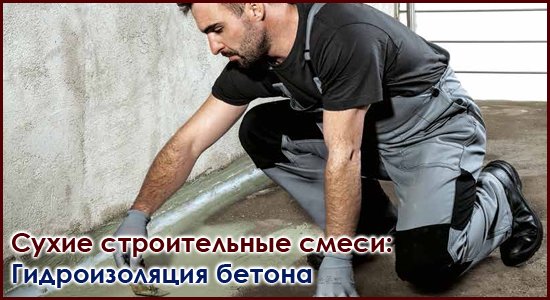
Like any materials, concrete is also susceptible to aging and changes in its structure when exposed to certain environmental factors, such as exposure to temperature extremes, moisture ingress, exposure to salts and acids. In addition, under significant dynamic loads, cracks may appear. We are not talking about errors in load calculations, but this happens, which entails the involvement of work on the repair and reinforcement of concrete.
To avoid premature aging, the concrete base should be protected with waterproofing compounds, which will prevent the penetration of moisture from the outside, which, accordingly, will leave the pores of the concrete dry and will not cause the manifestation of internal bursting loads in case of temperature and humidity changes.
Below are the main materials for waterproofing and concrete repair, with which you can protect new structures, as well as materials for repairs of various levels of complexity.
Waterproofing of concrete is necessary not only for industrial and civil structures, but also for domestic use: when arranging an apartment in wet rooms (for example, in a bathroom), it is advisable to use a waterproofing solution before installing a tiled cladding to protect load-bearing structures from moisture penetration.
A particularly relevant case of using concrete waterproofing is the treatment of a concrete base before laying clinker steps and floor tiles on balconies, terraces and entrances. The waterproofing layer protects the clinker tiles from moisture penetration from the base under the adhesive layer, which thereby prolongs its service life.
Waterproofing compounds are divided into rigid (implies use on rigid non-deforming bases that are not subject to dynamic loads); elastic (universally allowed for use both on rigid bases and on bases capable of deformation - for example, swimming pools and all outdoor structures subject to temperature extremes); and polymer waterproofing compounds, mainly used indoors.
Over waterproofing compounds, it is allowed to use tile adhesives and a cladding device. Waterproofing will protect the concrete base from the negative effects of environmental factors.
Materials for concrete repair are also presented in a wide range, but mainly for professional purposes. This means that if the need arises to "repair" the destroyed concrete, you first need to make calculations and measurements, identify the cause and consider all possible repair options
In the calculations, it is necessary to take into account not only the degree of destruction and dynamic effects, but also the design loads on the structure.
If you are the owner of a private house where the concrete base has collapsed (the foundation is leaking, the concrete elements of the house are crumbling, the steps of the entrance group have crumbled, etc.), before choosing a way to solve the problem, please, consult with a specialist of our company... Most likely, you will be offered the best solution for your problem.
It is important that you understand that when a leak appears inside the basement of your house, it is not enough to close the crack from where the water flows - it is important to solve the problem comprehensively, otherwise in a couple of months you will see water from another “crack”. With a similar problem, treatment with a banal water repellent, unfortunately, will not solve the problem.
In any case, call us - we will try to give you good advice.
Application
The waterproofing technology differs depending on the type of joints.
Interpanel
Poor sealing of interpanel seams leads to negative consequences: mold appears on the walls of the room, dampness, damp spots. To avoid these unpleasant moments, it is necessary to properly seal all the seams. Suture waterproofing must be done from the inside and outside of the building. This process takes place in several stages:
- The first step is to carefully remove old insulating material and various construction debris from the joint.
- After the seam is cleaned, it is necessary to apply a primer to the inner surface of the joint. The layer of primer applied must be thoroughly dried.
- The next step is to insulate the joints of the panels. To do this, you can use polyethylene foam or polyethylene foam.
- Then, on top of the installed special gasket, you need to apply a layer of mastic or sealant. The waterproofing material must be applied in such a way that the interpanel seam does not protrude as a bump.




Deformation
The main purpose of expansion joints is to compensate for various loads on structural elements of a structure. Such overloads occur under the influence of temperature changes and seismic activity. Waterproofing of expansion joints must be carried out, strictly observing all the requirements and nuances of technology.
Spreading is carried out as follows:
First you need to thoroughly dry the walls.
Further, the expansion joint is filled with crushed stone
It is important to remember that the material must be dry. Crushed stone is filled up in several stages, gradually.
Each layer of crushed stone is poured with bituminous mortar
This is necessary in order for the bitumen to fill all the voids between the fractions.
Then the operation is repeated, and so on several times, until the expansion joint is completely filled.

Cracks
As a result of precipitation, vertical cracks very often appear in the walls of various structures. To begin with, it is necessary to identify and eliminate the cause of the precipitation, and only after that you can begin to seal the cracks.
This is done as follows:
- minor damage on the surface of the walls expands slightly to make it easier to introduce the solution, while it is imperative to remove loose pieces of plaster;
- before applying the solution, the wall surface should be moistened;
- in consistency, the composition of the waterproofing solution should be identical to the composition of the plaster solution.

Ceilings
Seam waterproofing of the shelving can be done in several ways. The best option is to use special impregnating compounds. Penetrating into the concrete base, they combine with the salts that are contained in the concrete composition. This forms crystalline compounds. These compounds grow, adhering to the substrate, and serve as an excellent protection against moisture penetration.
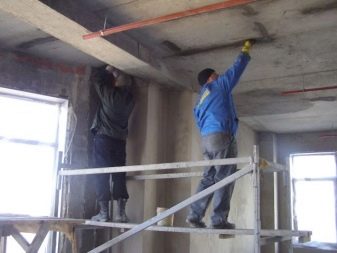

For seam waterproofing of the ceiling, in addition to penetrating compounds, a special tape will be required.The surface of the ceiling is thoroughly dried, cleaned of dirt and dust. Next, it is necessary to impregnate the seams and corner joints with an impregnating compound. After that, the treated surface is thoroughly dried. A special tape is applied and carefully rolled with a roller. Then another layer of impregnating compound is applied over the tape. The surface is dried. Next, you need to process the entire surface of the ceiling with an impregnating mixture. Two, in some cases three coats should be applied for better insulation.
Where is seam waterproofing applied?
This type of insulation work can be carried out in the following areas:
- in bathrooms, toilets;
- on walls in horizontal and vertical joints;
- during the construction of swimming pools;
- in basements;
- in parking lots;
- in tunnels, mines.
In any structure and structure in which there are inter-tile connections, insulation is used. There are a lot of materials for carrying out these works on the market, for example:
- high quality portland cement;
- quartz filler;
- dry additives to cement mixtures with various functions.
Dry formulations are very easy to prepare, just add the right amount of water. Treatment of seams increases the water resistance and frost resistance of the structure, while eliminating cold bridges.
According to its composition, the material for seam insulation is divided into two types:
- For expansion joints.
- For seams that are not subject to deformation during operation.
Overview of Concrete Joint Sealers
A sealant is a paste-like agent based on polymers or oligomers. Designed to fill various gaps and voids, it can be applied to moving and static joints. After evaporation of the solvent or in the course of contact with moisture, the mass solidifies, forming a strong sealing layer.
Expansion joint sealant must have special specifications to ensure air and water tightness of joints in concrete floors. Most of the products are created on the basis of modern modified resins, rubber, polymers of the urethane group, which provide them with good elasticity.
 Composition for filling expansion joints Germotex
Composition for filling expansion joints Germotex
It is the ability to stretch and return to its original state in the absence of shrinkage that is the main distinguishing property of sealants. If the elasticity index is not at the proper level, the seam will crack and crumble, and its service life will be reduced to a minimum.
Most of the concrete sealants are also suitable for other materials: stone, metal, wood, glass, tiles. The compounds can be applied to old or freshly poured concrete: after hardening, they penetrate deeply, ensuring the strength of the connection, and control the formation of cracks on the screed.
conclusions
If the surface is cracked, then a waterproof seam sealant will come to the rescue for high-quality sealing of deformation defects. He will help you repair rings, joints and seams from the inside.
There are many different types of sealants, each of which is used in a specific application. In order to choose the right tool, it is worth examining its characteristics. And the application of some of them can be complicated by additional actions that must be performed before carrying out work.

For information on how to properly use a concrete sealant, see the next video.










